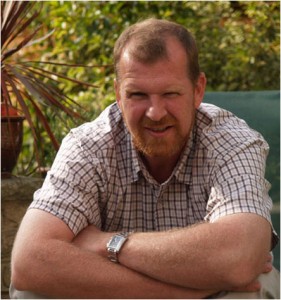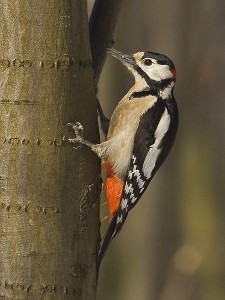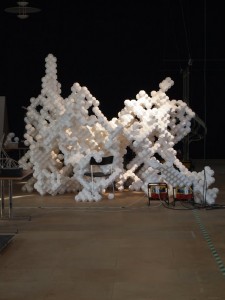TUESDAY, 20 DECEMBER 2011
A recent investigation revealed how woodpeckers manage to withstand the huge forces resulting from the activity that gives them their name [1]. This received widespread media attention due to its human applications in development of new protective headgear and helping to treat head injuries.Nature, due to its aesthetic appeal, has always influenced human design concepts. However, it is only recently that structures formed by natural selection, perfected over millions of years, have been used by scientists and engineers to improve upon man-made objects in a functional manner. This biomimetic design has allowed several major advances in human technology. For instance, the resemblance between the aerodynamic front of a Japanese bullet train and the streamlined beak of a kingfisher is not accidental. Both help to prevent the build-up of pressure at high speeds. Without it, the train would generate a deafening explosion of sound when exiting a tunnel at 200mph and the bird would be unable to dive into a river without being severely harmed.
Dr Rupert Soar is the CEO of Freeform Construction Ltd. Having embraced 3D printing technologies for use in the construction industry a decade ago, Dr. Soar now focuses on the use of natural selection in architectural design. Recently, in collaboration with Scott Turner (SUNY College of Environment Science & Forestry, New York), he identified an error in the use of termite mounds as an architectural model. Following a three year project documenting and describing the internal structure of mounds in Namibia, he found that regulation of internal climate differs from the model previously used by designers.
Dr. Soar spoke to BlueSci recently following a presentation to the Department of Zoology, University of Cambridge.
You’ve just spoken in front of some fairly influential zoologists, not architects or engineers. It seems talking to people from a broad spectrum of disciplines is a very integral part of what you do.
“My only regret these days is I made the decision to leave the safe confines of a university and the research to really see if I could bring this stuff out... in the worst world recession you could ever imagine. But that’s my ambition, and I hope I helped Scott [a physiologist by training] with scanning and digitization. My next ambition is to use these machines [3D printing technologies] so we can realize a dream of bringing, say, impedance structures into a physical building. This is something that not many people will see in their life-time, but that’s our overall dream”.
Some terms you used might not be all that well known outside of your sphere. For instance, you describe your work as ‘physiomimicry’ not ‘biomimicry’.
“I have a slight problem with the term biomimicry. After all most engineers are already doing some component of biomimicry. How can we do anything else than what we already find in nature?”
Biomimicry has a long history, for instance Leonardo DaVinci designing flying machines based on bird anatomies. Is your research into physiomimicry a departure from this?
“A classic example is Mike Pearce, a fantastic architect who built the Eastgate Tower known for it’s stack effect chimneys totally inspired by [the convection currents found in] the termite mounds of African termites. What Mick tried to do was build that entire building with a highly permeated surface and he had to get in with the builders themselves and cast all these block slabs, essentially creating a structure with such a massive surface area that it absorbs and releases heat as a fractal structure. He was trying to be a termite in that process. He’s known for this stack effect system, which is biomimicry, but he’s always wanted to transcend over that, by looking at the processes that actually take place within termite mounds”.
At the 2011 Smart Geometry conference, Dr Soar led an experimental design project whereby construction was guided by simple rules with no interaction between building teams. The rules dictated objectives such as structural stability and good ventilation. These structures closely mimicked models generated within computer simulations and operated more like functional mosaics (as seen in biological membranes) rather than traditional designs of buildings made up of modules of structures for specific task.
“What we’ve seen in computer simulations is no accident: that their solutions are completely the same as [those carried out by] nature’s agents.
If digital agents are indeed the same as natural agents - then we should be able to integrate the two seamlessly. I’m not talking about injecting nanites into my arm and healing my bone. What I’m saying is that if we placed a deposition robot over a cohort of termites, and if we’ve understood the termite algorithms for movement of soil… then theoretically we should be able to program this pick and place robot arm to squirt mud with pheromones in it and engage physically with a group of termites doing something.
Far flung, maybe, but this is where I see this going. It moves to a point where we see machines not as separately acting in a biological system, but actually integrating with the functions - the physiology - of the structure itself”.
Right now, what do you see as being additive manufacturing & physiomimicry’s most exciting application?
“It’s making huge inroads into prosthetics, printing stem cells, printing hydroxyapatite as a bone scaffolding system which is amazing work that myself and my colleagues have been doing. It’s a fantastic field. We’ve seen such a move forward in additive manufacturing and 3D printing in automotive, aerospace, consumer goods, medical, military, in every single sector - bar construction.
I’m biased because my passion has always been construction... the weird thing is if you were to ask ‘what has stopped it going into construction?’ then it’s partly the problem of building machines on building sites, but a more important issue is that construction and architecture is the only industry that separates design and manufacture. The industrial revolution stamped these apart and, like no other industry, it’s retained this difference. In every other engineering industry designers are working for the processes they’re making…We don’t do that in construction. But imagine if we could create structures and materials like that. Eventually we’ll find a merging of architecture and construction into one field. But that’s heretical”.
You’ve received a lot of media attention: you’re website’s [2] spilling over with hyperlinks to news sites and TV spots. Has this interest been mirrored by manufacturers as well?
“This is the adventure. Is anybody paying for impedance ventilation? No. Not right now. But we’re in discussions with a company in the far east that build 30,000 apartments a month that is very interested in it and would like to start a program, so we’re planning a technology transfer. They want to be the world leaders in sustainable, green technologies for housing... and the president is obsessed with termites. In his business strategy he’s stated that they will absorb all the information out there on termites and what we have to learn in order to integrate it into our constructions”.
So are these structures going to be ‘greener’ or more sustainable?
“Everyone has been talking about sustainability architecture since the 1990s. Sustainable structures and architecture began with the ideas of people like Norman Foster in the 1950s, but whenever I feel like riling up some architecture students at a viva I accuse them of contributing nothing to the sustainability argument.
Now that’s being obscenely harsh on them. But I really try to drive that home. We have to get to a point where design is manipulating those materials that form the geometry based around its functions and then we can claim sustainable architecture”.
Could these materials find a use in developing countries or is this this only a developed country design paradigm?
“Inevitably. Everything in the world is happening in developing countries in those transitional markets so that’s where we’re working”.
So do you think we’re going to start noticing a difference in manufactured products, for instance radical new building designs, over the ten years or so?
“Yes. You see them all the time now. Since I’ve been using these machines for ten years we’ve moved to freeform buildings, like the signature buildings Zaha-Hadid does. But not us. If I buy a house I’m going to buy a box. If you look at a car, if you look at a mobile phone, the markets they’re supplying are mass consumer markets… All these things that we take for granted in manufacturing and engineering haven’t even been touched on in construction yet. It’s still got to make that transition. And I think it wants to”.
Dr. Rupert Soar was invited to speak at the Department of Zoology’s ‘Tea Talks’ lecture series. Future talks in this series can be found at http://talks.cam.ac.uk/show/index/738
Written by Nick Crumpton



